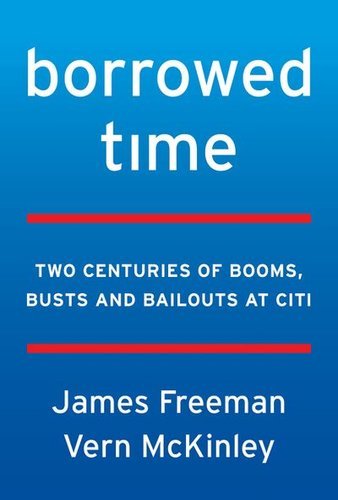BORROWED TIME
Two Centuries of Booms, Busts, and Bailouts at Citi
By James Freeman and Vern McKinley
365 pp. Harper Business. $35.
I was very much looking forward to reading “Borrowed Time,” James Freeman and Vern McKinley’s book about “two centuries of booms, busts, and bailouts” at Citigroup, once the nation’s largest bank. (It is now fourth largest, by assets.) I was hoping the authors would deliver a much-needed, and definitive, explanation about how and why a decade ago the federal government decided to rescue Citigroup instead of letting it go down the tubes, where it probably belonged given how unhinged the bank’s risk-taking had become. After all, there have been many books about the 2008 financial crisis and how various Wall Street banks did, or did not, survive it. But there has never been an accounting of how Citigroup got itself into so much trouble and why the decisions were made to bail it out — to the tune of, as the authors reveal, more than $517 billion all told, some $40 billion more than the roughly $476 billion in cash and guarantees described in a 2011 congressional report.
That there hasn’t yet been a treatment of the Citigroup debacle is a noteworthy omission in the canon, considering how what happened at Citigroup bucks the conventional wisdom about the financial crisis: to wit, that it was fomented and exacerbated by the so-called investment banks — like Bear Stearns, Lehman Brothers and Merrill Lynch — and that the so-called commercial banks — like JPMorganChase and Bank of America — came to their financial rescue. (Except, of course, for Lehman Brothers, which was not rescued and then failed in spectacular fashion.) Recognizing that different types of institutions ended up with different outcomes contrasts with the views of political progressives like Senators Elizabeth Warren and Sherrod Brown that none of this would have happened if only the Glass-Steagall Act, the Depression-era law separating commercial banking from investment banking, had never been repealed in 1999. The repeal allowed for the blockbuster merger of Citibank and Travelers, which owned Salomon Brothers and Smith Barney, two investment banks, and created Citigroup in the first place. But those, like me, who have argued that repealing Glass-Steagall did not cause the 2008 financial crisis have always stubbed their toe on Citigroup because it wreaked so much havoc before its enormous bailout.

The authors certainly would appear to have the credentials for a revelatory work of narrative nonfiction. Freeman, a longtime columnist at The Wall Street Journal, is also an assistant editor on the paper’s editorial page. He was once an “investor advocate” at the Securities and Exchange Commission. His collaborator, McKinley, a visiting scholar at George Washington University Law School, is a self-proclaimed specialist in “diagnosing financial instability” in the banking system and a former employee of the Federal Reserve Board of Governors. They also had a compelling thesis through which to explore why the feds bailed out Citigroup in 2008: that throughout the bank’s 206-year history it has often teetered on the edge of financial ruin, only to be rescued repeatedly by friends in high places.
Article source: https://www.nytimes.com/2018/08/06/books/review/james-freeman-vern-mckinley-borrowed-time.html?partner=rss&emc=rss
Speak Your Mind
You must be logged in to post a comment.